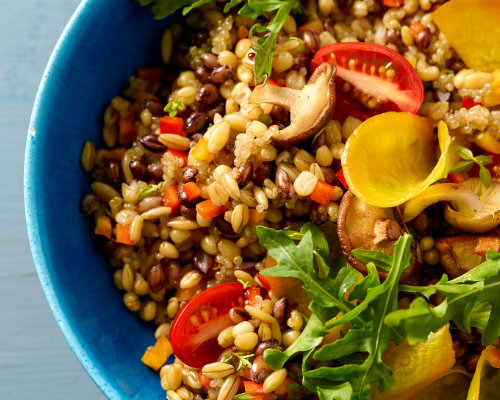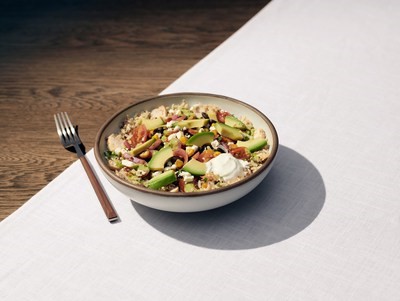Mostly plant-based does not mean meat and poultry free. In fact, the very popular bowl meal – sold fresh in many supermarkets, as well as frozen, along with made-to-order at a growing number of foodservice outlets – is the perfect melding of plant and animal. While some bowls feature traditional pasta or rice, more are including ancient grains for their unique flavors, textures and nutrition.
Ancient grains have been feeding man since the beginning of civilization but have been largely ignored by Western countries where selectively bred and refined grains provide an economic advantage. While there is no official definition of what qualifies as an ancient grain, the Whole Grains Council describes ancient grains as those that have been largely unchanged since the beginning of time. This definition suggests modern varieties of corn, rice and wheat, which are products of years of selective breeding, are not ancient grains.
Many ancient grains cook up much like pasta and rice. They add culinary adventure and great-tasting whole grain nutrition to all types of foods, with each grain delivering unique flavors and textures. They also provide a back-to-basics approach to food preparation, a wholesomeness embraced by today’s consumers.
Manufacturers of packaged bowl meals may procure ready-cooked grains for easy assemblage. Depending on the application, storage (refrigerated or frozen) and desired shelf life, formulators may choose from ancient grains that are fully or par-cooked, refrigerated – sous vide with seasonings – and individually quick frozen. There are many flavorful options available.

Panera is entering the bowl meal category with the launch of Baja and Mediterranean, with both varieties featuring cilantro-lime long grain brown rice, a mix of red and golden quinoa, various greens and vegetables, and grilled citrus pepper-seasoned lean chicken. The company uses only chicken raised without antibiotics. The protein-rich grains and chicken provide at least 29 grams of protein in each bowl.
“Interest in bowls that feature an abundance of nutrient-dense, fresh, layered ingredients, lean protein, veggies, grains and flavorful sauces is on the rise,” says Dan Wegiel, executive vice president, chief growth and strategy officer at Panera.
Earlier this year, Moe’s Southwest Grill introduced the Quinoa Power Bowl. The bowl packs all the Southwest flavor that Moe’s is known for with higher protein and fiber and lower carbohydrates. It is made with Mojo chicken (all-natural white meat chicken breast), quinoa blend (quinoa, brown rice, sweet potato and zucchini), frijoles, shredded romaine lettuce, corn pico, guacamole, cilantro and queso fresco.

Here are some of the more popular ancient grains and their culinary profile:
Amaranth is an Aztec grain that is high in fiber and protein, as well as multiple vitamins and minerals. It has a sticky, gelatinous texture and a nutty, slightly earthy and spicy flavor with peppery notes. It cooks up like a thick, creamy porridge with a bit of crunch.
Barley is a gluten-containing grain that packs in the fiber, some of which is the form of beta-glucan, a soluble fiber with recognized health benefits. Mildly flavored, the pearled variety is chewy, while whole barley very chewy.
Buckwheat is not part of the wheat family and is gluten free. It’s a dark red grain with an intense roasted, nutty flavor.
Einkorn, Farro and Spelt are basically the same grain. Names vary because of country of origin. Because of this grain’s low-gluten content, it is often favored by those who cannot tolerate wheat. It contains about 40 percent more protein and 15 percent less starch than commercial wheat, and is abundant in B vitamins and trace minerals, including iron. It has a nutlike flavor with a hint of sweetness, making it very versatile.
Freekeh is a high-fiber and high-protein young green wheat that has been toasted and cracked. It has a chewy texture with a smoky flavor.
Kamut is a wheat with about 30 percent more protein and more healthful fatty acids than traditional wheat. Though it’s not gluten free, some people who are allergic to wheat can tolerate kamut. It has a chewy texture and buttery, nutty, sweet flavor.
Millet is a tiny, gluten-free seed-like grain that is easy to digest. It has a bland, neutral flavor and cooks up like rice.
Oats are inherently gluten free; however, commercially rolled oats are often processed in facilities with wheat, making contamination possible. The steel-cut version is considered the “ancient” variety, as it is minimally processed and has a coarser texture and nuttier flavor than rolled oats.
Purple Corn is cultivated from an ancient species of Andean purple corn. Rich in anthocyanins, polyphenols and flavonoids, purple corn can be used in the same manner as other corn ingredients and has the same corn flavor and texture.
Quinoa is a tiny, disk-shaped seed that is recognized as the only grain containing all the essential amino acids in a healthful balance, rendering it a complete protein. It has an unusually high ratio of protein to fiber and is very high in potassium. This versatile light grain has a slight nutty flavor.
Sorghum is similar to corn. This gluten-free grain cooks up like rice and is light in color with a slightly sweet mild flavor.
Teff is a gluten-free grain best known for being very high in calcium and fiber. It cooks up into a creamy texture with a sweet, nutty, molasses-like flavor.

